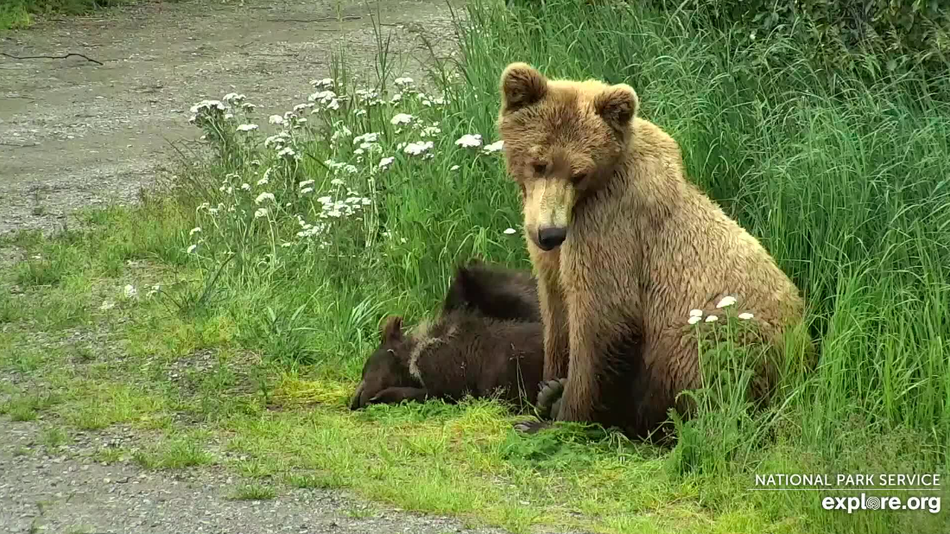While walking along Alaska’s Brooks River on Tuesday, a cub stumbled while viewers watched apprehensively on the bear cams. The clearly enfeebled young bear struggled to keep up with its mother and two siblings. Eventually, the cub vanished into the high summer grass. There, park rangers later confirmed the bear died.
The explore.org bear cams — one of the most-watched wildlife cams in the world — allow global viewers to view eating, sleeping, and fishing brown bears in Alaska’s remote Katmai National Park and Preserve over the summer, notably in July and September, when activity is at its highest.
But the opportunity to watch these wild bears in their salmon-rich environs also means witnessing the unedited, and at times grim, natural world. Bear 803, a mother who returned to Katmai’s Brooks River this summer (where the bear cams are located), has two remaining cubs. This family group will try to endure in a wild world that is as cruel as it is captivating, as bear 803 attempts to feed herself and her cubs with ample amounts of 4,500-calorie salmon. The goal is to catch fish and fatten up before the great winter famine hits, and the bears hibernate.
“We get to see their ingenuity and skill,” Mike Fitz, the resident naturalist for explore.org and a former park ranger at Katmai, told Mashable. “But we see things that don’t always work out in an ideal way, from a human perspective.”
On the livestream, bear 803 backtracked to assess or perhaps encourage the straggling cub, the runt of the litter. Near the end of its life, the cub was able to swim to an island in the river. “803 kept checking on it,” said Fitz. “It went to the island and just never came out.”

Bear 803 with her remaining two cubs on July 7.
Moms are perseverant. Bear 803 carries on with her two cubs, as we remember and pay homage to the little one who passed last night. Nature is often harsh, but it is also beautiful ❤️ pic.twitter.com/hhhXyg6syD
— explore.org (@exploreorg) July 8, 2020
The bear cams provide rich insight into the lives of Katmai’s famous megafauna. But there’s still much we don’t see beyond the cams, in the thick woods and beyond, grown over in dense willows, spruce, and birch.
“Death is common,” Naomi Boak, the media ranger at Katmai National Park and Preserve, told Mashable. “We’re removed from it. There’s a lot we’re not aware of.”
Bears live in competitive worlds. Sometimes an adult bear will be killed by another bear. Sometimes large, dominant males kill cubs.
Cubs are the most vulnerable of all, particularly during their first year of life. They have the threats of disease, malnutrition, and other bears, among countless other perils. At Katmai, research shows that two of three cubs don’t survive their first year of life. “That’s an extremely high mortality rate,” said Fitz.
It’s unknown what killed bear 803’s cub. Perhaps a virus. Perhaps malnutrition. “There’s a million different potential reasons,” noted Fitz.
Yet, against many odds, bears consistently prove resilient, even when you least expect it. In the summer of 2014 on the bear cams, a mother abandoned her 1.5-year-old cub, leaving the bear helpless and likely to soon starve to death. But the cub didn’t die. He was, to the amazement of park rangers, adopted by another bear, and has since grown into a large, healthy bear (bear 503). Adult bears persevere too, overcoming what appear to be serious injuries (limping, missing teeth, or skin ripped off their back in a fight), but find ways to survive and fatten up for the long winter.
“Bears are really resilient,” said Boak.
Many national parks, like Katmai, preserve wilderness areas, so when an animal is naturally injured or sick, the park will not intervene. That’s part of conserving the wild — its glories and, in our view, misfortunes.
“It is hard to watch a bear die,” said Fitz, noting that they are intelligent animals. “But I know bears live in a world that’s tough and challenging.”
After bear 803’s cub died, she was seen later that day on the cams nursing her two other young, largely helpless cubs.
“Life goes on,” said Boak.
